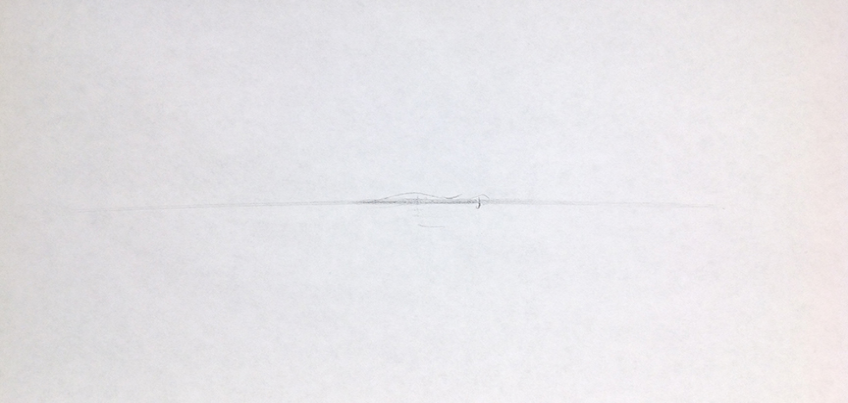
Exhibition Information

Forbidden Regions
January 27 - February 28
The minimal, ink, and graphite drawings are the physical manifestation of the invisible world of quantum mechanics that form parabolic overlaps found in other disciplines. The premise for this series is to offer an ambiguous view into a process that begins as a quantifiable theory and ends in the realm of hypothesis and assumption. Interleaving of structures and ideas progressing from the meta-cognitive speculation of universal principles through physical intermediaries to the concrete truth of transient and fuzzy reality. Although these notations are not classified as precise scientific illustrations, they allude to ideals of symbolic representation rooted in fields as broad as anthropology, sociology, and mathematics. They serve as placeholders for notions like documentation, the transference of information, the loss of data in information copy, the necessity of statistical interpretations, metaphysics of heritage, and the dynamics of social structures. Recorded markings are simultaneously primitive and technological, a prosthetic extension of the mind, a transference of idea to paper through the intermediary of a mechanical apparatus designed with the intention to convey abstract thought.
The repetitive motions of an interlinked network of objects draw parallels with complexities and simplicities of our social structures. The masses might be imagined as individuals activated by external forces imposed on them, and as a result, contribute to the collective motion through an energy transfer onto the world to which they connect. The trajectories captured on the paper represent feedback loops predetermined by a set of circumstances, and the individual and collective inability to fundamentally change the outcome.
These seemingly simple drawings reference a complex array of ideas investigated by many individuals, from metaphysical teachings of Aristotle to many contemporary scholars and artists such as Taryn Simon, Mark Lombardi, Dario Robleto, Patrick Feaster, Theo Jensen or Gustav Metzger.
In addition to the abstract and open-ended content of this study, the individual frames, separated from the whole, create autonomous objects with a distinctive aesthetic quality that carries a potential for a representational narrative.
This collaboration is a part of the Measured Confluence exhibition presented in the main gallery space on view until February 28.
About artists:
Dr. Eric Edlund is an Assistant Professor of Physics at SUNY Cortland. Here he teaches the set of introductory, calculus-based physics courses. His primary pedagogical interest is a development of inquiry-based, active-learning laboratory experiences that both engage student interests and ground theoretical concepts in personal experience. Previously, Dr. Edlund worked as a research scientist at M.I.T.’s Plasma Science and Fusion Center. Among other things, Dr. Edlund wrote a grant that received over $1M from the U.S. Department of Energy for the development of “phase-contrast imaging” diagnostic for the Wendelstein 7-X stellarator facility located in Greifswald, Germany. That diagnostic successfully operated for two years and produced many interesting measurements of plasma turbulence; this project now continues into its 5th year. Dr. Edlund conducted his postdoctoral research at the Princeton Plasma Physics Laboratory, where he studied angular momentum transport in astrophysical bodies. His current research continues with the Wendelstein 7-X facility, and he is developing a new experiment that will revisit studies form his past related to fluid turbulence. Dr. Edlund studied physics and mathematics at the California State University at Chico and earned his Ph.D. at M.I.T., where he studied the propagation of electromagnetic waves in tokamak plasmas.
Jaroslava Prihodova is a visual artist, designer, and curator interested in interdisciplinary topics and collaborations. Her artistic practice generally revolves around issues associated with the object. She spent most of her informative years developing language that sufficiently translates ideas into a material. As a maker, Prihodova often explores ideas and their application across disciplines. As a result, she continually searches for a balance between several core doctrines: design, science, and fine art. In many instances, this schism creates a climate for particular limitations with interesting challenges. Prihodova received her BFA from School of Art and Design, Studio of Natural Materials, Jan Evangelista Purkyne University, Usti nad Labem, Czech Republic, and MFA from School of Visual and Performing Arts, Jewelry and Metalsmithing, Syracuse University, NY. She now works as the director of the Dowd Gallery at SUNY Cortland, NY.
Office Information
Dowd Fine Arts Center, Room 106,
48 Graham Avenue and Prospect Terrace Cortland, NY 13045
Phone: 607-753-4216
Fax: 607-753-5934
Contact:
Scott Oldfield, Interim Director
scott.oldfield@cortland.edu
Hours:
Mon, Tue, Wed, Fri: 10 a.m.-5:30 p.m.
Thr: 10 a.m. - 7 p.m.
Walk-ins are welcome. You may also schedule a visit.
The gallery is closed when the College is not in session

